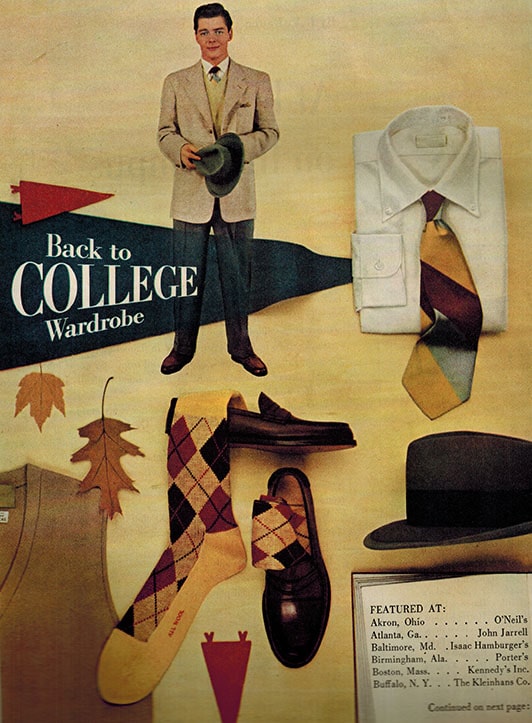
Back-to-school time is once again right around the corner. Millions of recent high school graduates will be heading off to colleges and universities to fill their minds with knowledge and their bellies with ramen. New students are thinking about a lot of things — what friends they’ll make, what classes they’ll take, and what it’ll be like being away from home for the first time.
What they’re probably not thinking about, unfortunately, are the loans they’ve likely taken out to pay for the education and experience that awaits them. This aversion is understandable — the world of student loans is confusing, overwhelming, and seems disconnected from the present. It’s something you can worry about in 4-6 years, right?
Wrong. Taking the time right now to understand how student loans work will save you money and headaches down the road. So if you’re a young gent (or the parent of one) who’s heading off to college this year or next, we offer this accessible primer on the basics you should know about student loans.
If this info comes too late for you, as you’ve already graduated and are struggling with your student debt, later this week we’ll offer tips for paying it down.
Reduce the Amount You Need to Borrow
Before you consider taking out student loans, it’s financially prudent to find as many ways as possible to reduce the amount you need to borrow in the first place. The less debt you take on now, the less you have to pay back after college. It’s hard to overestimate how much you’ll appreciate even a small reduction in your total debt later on, but trust me, someday you will.
Know that about 2/3 of all college students graduate with student debt, and the average debt is about $30,000. It’s hard for a young man to put that into perspective, but when you’re repaying that loan, the average bill per month is about $320. When combined with other bills and debts, and especially when you get married, it will be a large chunk of your monthly budget. In fact, only about 60% of all student loans are being actively repaid at any given time; this means that just under half of all borrowers can’t afford that monthly payment (and failing to pay has dire consequences which we’ll discuss next time). These are just numbers, of course, but are sobering nonetheless, and hopefully give some credence to the reality of student loans and the necessity of reducing them as much as you can.
Save for college. Sure, you’re probably not going to be able to save enough money from your high school job to pay for the entirety of your college education, but every little bit helps. So get out there and get a job. Use some of that money for fun, but be sure to set aside a chunk for school.
If you’re a parent with young children, start thinking ahead by opening up a 529 account with your state to save money for your kid’s future education. Contribute a little bit each month. The money you contribute is taxable, but it grows interest-free. Also consider asking family members to contribute as Christmas and birthday gifts, especially early on when Junior won’t know the difference anyway.
Apply for scholarships. I wish I sought out more scholarships when I was applying for my undergraduate degree. I think I applied for like five, and I ended up getting one for a few hundred dollars. But I had only scratched the surface — there are literally thousands of opportunities out there. Don’t just apply for the scholarships that your school offers — a lot of organizations have scholarship funds available, and in many cases that money doesn’t even get dispersed because no one ever applies for it. Thanks to the internet, hunting for scholarships is a breeze. Search these sites for scholarship opportunities:
Once you put together a big list of scholarships, dedicate a few hours each weekend to submitting the applications. Sure, it’s tedious and boring, but if you can score a few thousand dollars to go towards your tuition, it’s completely worth it.
“Moneyball” your way through college. Last year AoM guest contributor Jay Cross published an article on how to use CLEP exams to reduce the amount you pay in college tuition. The tests cost just $80 each, but if you pass, you don’t have to take that class in college, saving yourself hundreds or thousands of dollars.
Coupling CLEP exams with taking AP classes (and passing the exam) in high school is another effective way to save big-time money and months of your time. Using a combination of AP exam credit and CLEP exams, I was able to shave off a whole year of college. It was awesome!
Go to a community college the first two years. If you can’t CLEP out of some of your general ed requirements, consider attending a local community college for the first two years of your schooling. Sure, you’re not getting the “full college experience,” but you’ll save a lot of money.
Live at home. My first semester of college I lived in the dorms at OU. It was a blast, but my grades suffered, and it cost me several thousand dollars. At the end of the semester, I decided to transfer to a college in my hometown and move back in with my folks. The tuition was much cheaper, plus I saved a ton of money on living expenses. And as a bonus, I had a 4.0 my second semester.
If it’s an option, consider living with your folks while you’re in college. Sure, they’ll cramp your style some, but you’ll be amazed at how much money you’ll save and how much more productive you’ll be.
Don’t take the full amount of student loans offered you. Before school starts, you’ll get a letter telling you how much in student loans you’ve been approved for. You don’t have to accept the full amount. Take a look at your whole financial situation and decide how much you need to make it through the college year. Many students take the full amount and use what’s left over after tuition and books as spending money. But if you work while you’re going to school, you won’t need to do that. Which brings me to my next point…
Work your way through college. Yes, school should be your top priority. But with efficient use of your time, you can make room for a part-time job. I waited tables and made smoothies throughout college. And most schools offer on-campus jobs that are pretty easy to get, and of course flexible with your class schedule.
Because I had money to pay for my living expenses, I didn’t have to take the full loan amount I was offered each semester. I typically just took enough to cover my tuition and books, and I saved thousands of dollars because of that.
Understand the Two Types of Student Loans
So you’ve done all you can to reduce the amount you need to borrow, but you still have to take on some loans.
Student loans will come in two broad categories: federal student loans and private loans. With federal student loans, the U.S. government is your lender. Thanks to various laws, money lent by the government comes with provisions to help you manage your student debt, such as fixed, relatively low-interest rates, grace periods, and flexible repayment plans.
With private loans, a bank or some other institution is your lender. The company you borrow the money from sets the rules on repayment and they’re not as generous as Uncle Sam.
To help you navigate the various types of student loans out there, we’ve created this handy-dandy chart:
| Federal: With federal loans, the U.S. Department of Education is your lender | |
| Direct Subsidized Loans (a.k.a. subsidized loans) | Direct subsidized loans are available to undergraduate students with a financial need (graduate students are not eligible for subsidized loans). Your school determines how much money you can borrow. The big benefit of subsidized loans is that the federal government pays the interest on them while you are enrolled at least half-time in school, during the six-month grace period after you graduate (during which you don’t have to make payments on your loan) and during deferment periods. (Note: If you received a Direct Subsidized Loan between July 1, 2012 and July 1, 2014, you are responsible for paying any interest that accrues during your grace period.) The interest rate is fixed, meaning that it can’t go up after you’ve taken the loan out. |
| Direct Unsubsidized Loans (a.k.a. unsubsidized loans) | Direct unsubsidized loans are available to any undergraduate or gradate student, regardless of financial need. Your school will determine how much you can borrow by taking into account the cost of attendance as well as other financial aid you’re receiving (including scholarships and grants). Unlike subsidized loans, you’re responsible for paying the interest on unsubsidized loans starting from the date you received the loan — whether it’s during your grace period, while you’re enrolled, or while it’s in deferment. If you decide not to pay the interest while you’re in school and during the grace periods, your interest will accrue and then be added to the principal amount of your loan. The interest rate is fixed, meaning that it can’t go up after you’ve taken the loan out. |
| Direct PLUS Loans (a.k.a. PLUS loans) | These loans are for graduate or professional degree students or for parents of dependent undergraduate students. To be eligible for a PLUS Loan, you can’t have an adverse credit history. Like unsubsidized loans, you are responsible for paying the interest on PLUS loans from the date you receive the loan, regardless of whether you’re in a grace period, enrolled, or have them in deferment. The interest rate is fixed, meaning that it can’t go up after you’ve taken the loan out. |
| Federal Family Education Loan (FFEL) | The FFEL program no longer exists, but if you went to college before 2010, there’s a chance you could have this type of loan. FFEL loans were given by private lenders, but backed by the federal government, with the same repayment options and protections as federal loans. |
| Federal Perkins Loan | This is a loan that’s issued by the schools to students with exceptional financial need. While the school is the lender (and you’ll be paying them back), because the loans are subsidized by the federal government, you’re eligible for many of the protections and repayment options that you get from direct loans from the feds. |
| Private Loans | |
| Private loans do not come from the federal government. These are loans you get from banks, schools, relatives, and non-profit institutions. There are no federal rules governing the terms of private loans, thus you’re not guaranteed a fixed interest rate and there aren’t any deferment options. With private loans, you may have to start paying back your loans while you’re still in school. | |
Determining Your Eligibility for Federal Student Loans
To be eligible for any federal student loan, you must meet a few baseline requirements. Most are what you’d expect: graduate high school, be enrolled or accepted to an accredited college, have a valid Social Security Card.
The one eligibility requirement that I didn’t know about and that is unique to men is that you have to be registered with the Selective Service if you’re between the ages of 18 and 25. Uncle Sam won’t give you any loans unless you’re willing to be drafted into World War III.
If you meet the above requirements, then you just need to fill out and submit a Free Application for Federal Student Aid (FAFSA). You can submit applications for the fall semester after January 1. The earlier you submit your FAFSA application, the better. It takes awhile to fill out, so look to set aside about an hour if you’re a first-time applicant.
When Do You Have to Start Paying Back Your Student Loans?
With both federal subsidized and unsubsidized student loans, you’re a given a six-month grace period before you’re required to start paying back your loan. The grace period starts after you gradate, leave school, or drop below half-time enrollment. Just remember, with unsubsidized student loans, you’ll be accruing interest during your grace period and the interest will be added to your total principal. With subsidized loans, the grace period is interest-free.
When it comes to student loans, a little knowledge goes a long way. Do what you can to reduce the amount you borrow, understand the nature of the loans you’re taking, and start thinking now about how you’ll pay them back after you get your sheepskin.
Make sure to read the follow-up: A Guide to Paying Back Your Student Loans
Tags: College






